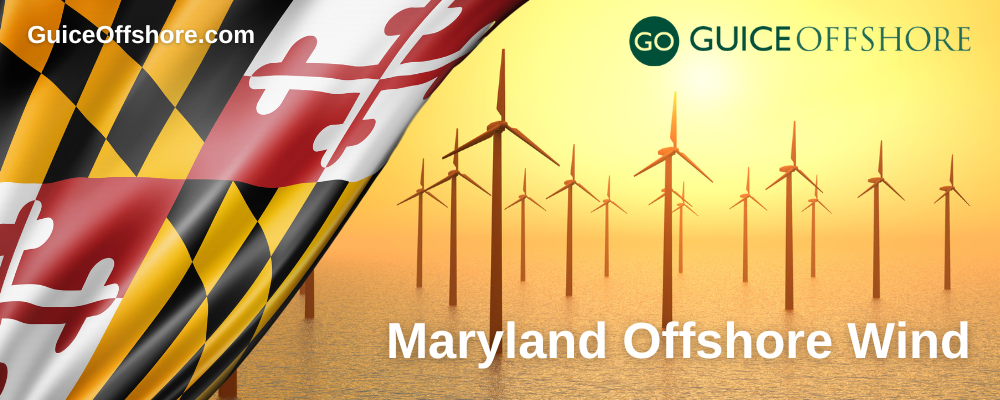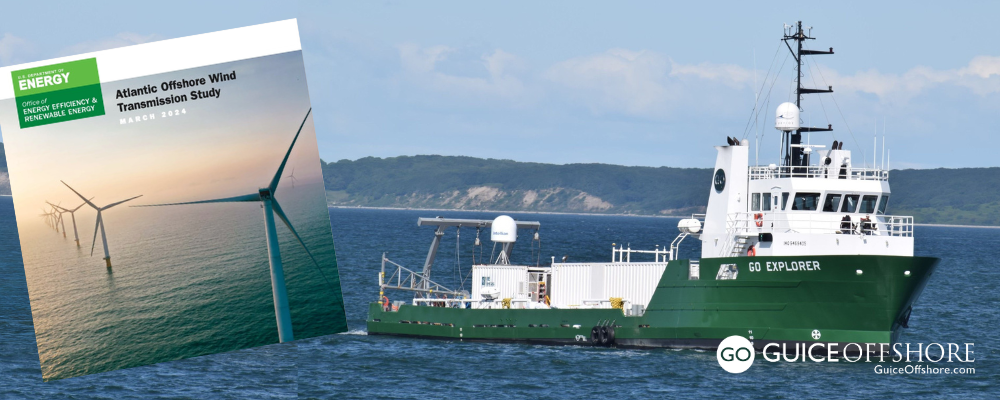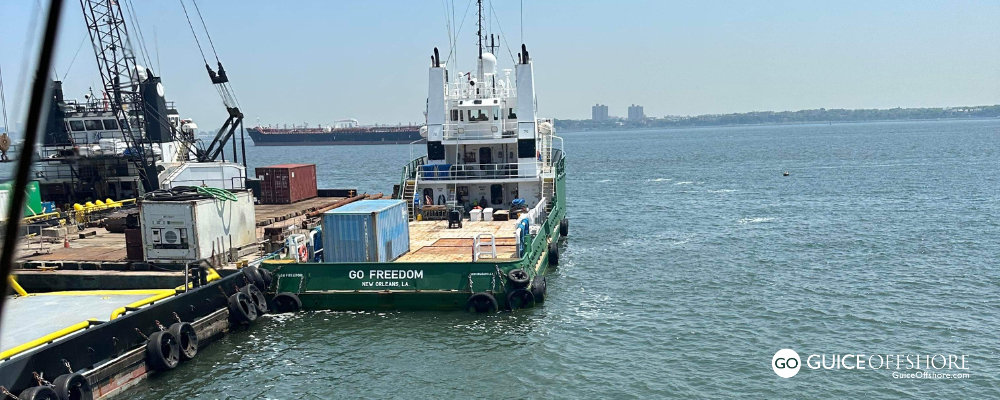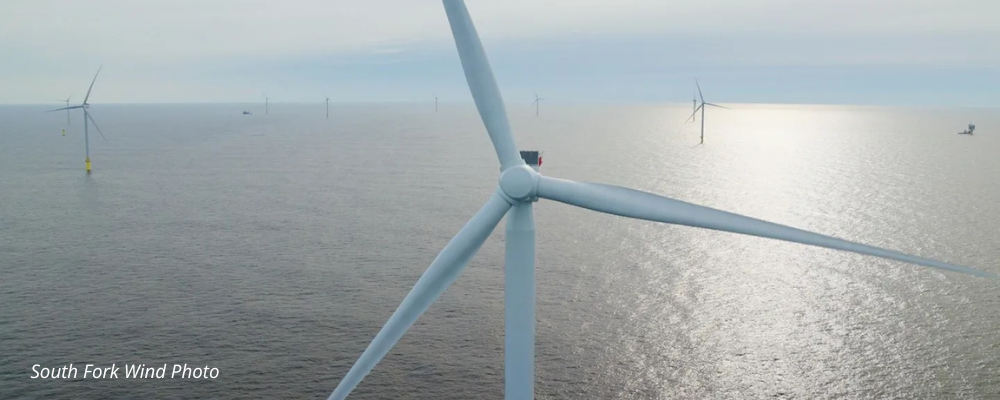Continuing the momentum to achieve deployment of 30 gigawatts of offshore wind energy capacity by 2030, the U.S. Department of the Interior announced this week on June 6, 2022 that the Bureau of Ocean Energy Management (BOEM) will conduct an environmental review of the first proposed wind energy project in the Maryland offshore area.
The transparent, careful and well-documented process whereby an offshore wind leasing site is approved and leased is moving quickly and thoroughly in order to ensure input by all stakeholders and interested parties is incorporated. In anticipation of both the governmental and offshore wind energy industry’s need for subsea surveying, equipment and supply transport, along with crew transfer, among other maritime infrastructure-building requirements, Guice Offshore (GO) has added three new vessels to its fleet, including another 170 ft. DP1 multi-purpose vessel and two 205 ft. DP2 platform support vessels. Based in Louisiana and operating nationwide in North America, Central America, South America and the Caribbean, Guice Offshore is widely considered to be the U.S. flag leader in operating dynamically positioned mini supply and medium-sized multi-purpose vessels in the specialty market.
The regulatory process works to begin Maryland offshore wind power works like this:
Following its announcement, the Interior Department has now published a Notice of Intent (NOI) to prepare an Environmental Impact Statement (EIS) for the Construction and Operations Plan (COP) submitted by US Wind, LLC (US Wind). This is the 10th offshore wind energy COP review initiated under the Biden-Harris Administration.
To read the NOI, click here.
The lease area is approximately 10 nautical miles off the coast of Ocean City, Maryland, and approximately nine nautical miles offshore Sussex County, Delaware. If approved, the development and construction phases of the US Wind project could support up to an estimated 2,679 jobs annually over seven years.
“If approved, this project will represent another step forward to creating a robust offshore wind industry here in the United States, all while creating good-paying, family-supporting jobs,” said BOEM Director Amanda Lefton. “We are committed to using the best available science and traditional knowledge to inform our decisions and protect the ocean environment and marine life. We look forward to receiving input from our government partners, ocean users and other stakeholders, which is critical to a successful environmental review process.”
In addition, this past fall, the federal government announced a new leasing path forward, which identified up to seven potential offshore wind energy lease sales by 2025.
A recent report indicates the United States’ growing offshore wind energy industry presents a $109 billion revenue opportunity to businesses in the supply chain over the next decade.
The publication of the NOI opens a 30-day public comment period through July 8, 2022 as part of the process to help BOEM determine the scope of its environmental review.
Highlights from US Wind’s proposal include the following:
- Construction and operation of an offshore wind project with a total capacity between 1,100 and 2,000 megawatts of clean, renewable wind energy to the Delmarva Peninsula, which could power as many as 650,000 homes in Delaware, Maryland and Virginia each year.
- Installation of up to 121 turbines, up to four offshore substation platforms, one meteorological tower and up to four offshore export cable corridors, which are planned to make landfall at 3 R’s Beach or Tower Road in the Delaware Seashore State Park in Rehoboth Beach, Delaware.
The NOI public comment period will help identify what BOEM should consider as part of its environmental review of US Wind’s COP. Throughout the scoping process, multiple opportunities exist to help BOEM determine the important resources and issues, impact-producing factors, reasonable alternatives and potential mitigating measures that should be analyzed in the EIS.
During the public comment period, BOEM will hold three virtual public scoping meetings to inform the preparation of the EIS on the following dates and times:
- Tuesday, June 21, at 5 p.m. ET
- Thursday, June 23, at 5 p.m. ET
- Monday, June 27, at 1 p.m. ET
Registration for the virtual public meetings and detailed information about the proposed wind energy facility, including how to comment, can be found on BOEM’s website.
How to Participate in the Maryland Offshore Wind Process
The NOI published in the Federal Register on June 8 opened a 30-day comment period during which the BOEM is seeking input to determine the scope of important resources and issues, potential impacts to the environment, reasonable alternatives, and mitigation measures to be analyzed in the EIS.
During the public comment, BOEM will hold three virtual public meetings where members of the public can learn more about the project, ask questions, and provide oral testimony.
BOEM’s virtual scoping meetings, which will follow a similar agenda, are planned for the following dates and times (Eastern):
- Tuesday, June 21, 2022, 5:00 p.m. EST
- Thursday, June 23, 2022, 5:00 p.m. EST
- Monday, June 27, 2022, 1:00 p.m. EST
Registration for the meetings can be done at the following:
https://www.zoomgov.com/webinar/register/WN_-h4_l_XFTt2R-k5VO7mt4Q
+1 888 788 0099 US (West Coast USA)
+1 833 548 0276 US (East Coast USA)
Webinar ID: 161 277 6799
Passcode: 181781
About Maryland Offshore Wind
To read a full history of Maryland Offshore Wind activities, click here.
In an effort to encourage offshore wind development off its coast, the state of Maryland enacted the Maryland Offshore Wind Energy Act of 2013. This initiative revised the Renewable Portfolio Standard (RPS) goal to source 25 percent of all electricity consumed in the State from renewable energy by the year 2020 and created a “carve-out” for offshore wind not to exceed 2.5 percent (about 500 MW) of the overall RPS.
In November 2016, the Maryland Public Service Commission (PSC) began reviewing two proposed projects submitted by Skipjack Offshore Energy, LLC (Ørsted, A/S) and US Wind, Inc. (Round 1 Projects) which total 368 MW. On May 11, 2017, the PSC announced in Order No. 88192 that both projects were approved with conditions.
The RPS was revised again in 2019 through the Clean Energy Jobs Act (CEJA) which increased Maryland’s overall RPS to 50 percent by 2030. The CEJA removed the upper limit on offshore wind development and specifically required at least an additional 1,200 MW of Round 2 Projects through three new rounds of offshore wind procurement.
In July 2021, the PSC initiated the first procurement and began reviewing five proposed project applications. On December 17, 2021, the PSC announced in Order No. 90011 (and errata) it approved with conditions Ørsted’s Skipjack Wind Phase 2.1 and US Wind’s Momentum Wind (Bid 2) applications (Round 2 Projects) which total 1,654.5 MW. Once these projects reach commerical operation in 2026, Maryland will surpass its offshore wind development goal by more than 400 MW and four years ahead of schedule.
Maryland’s total offshore wind market (Round 1 and Round 2) stands at 2,022.5 MW which should provide enough electricity to power about 600,000 average homes. These projects are estimated to create more than 12,000 direct full time equivalent (FTE) jobs during the development and constructions phase and more than 3,000 direct FTE jobs during the 20 – 30 year operations and maintenance phase. These projects will support Maryland’s growing offshore wind supply chain and result in at least $1.5 Billion of in-state expenditures including investments of $40 million for port infrastrucutre, $76 million for steel fabrication, $150 million for monopile foundation manufacturing, $140 million for subsea cable manufacturing, and $100+ million for a turbine tower manufacturing.
Both project developers have committed to small, minority, woman, and veteran owned business participation goals of 15 percent (US Wind) and 29 percent (Ørsted) during project development.
MEA Offshore Wind Grant Programs
The Maryland Energy Administration (MEA) has funding opportunities available to businesses, including minority owned emerging businesses, non-profits, academic institutions, labor unions, and state, local, and municipal governments to help establish an offshore wind supply chain and experienced workforce.
Click on the links below to learn more about these unique opportunities.
Offshore Wind Business Development Grant Program
Offshore Wind Workforce Development Grant Program
Maryland Energy Administration Offshore Wind Research
MEA supports research initiatives which facilitate offshore wind development and scientific understanding of the environment, wildlife, habitat, and ecosystems present on the mid-Atlantic Outer Continental Shelf.
Click on the link below to learn more about these initiatives.
Research Supporting Offshore Wind Development
Resources
MEA has compiled a number of useful resources that will help you understand the basics of wind energy, deployment of small and community scale wind projects, and how you can plan a career in the wind energy industry.
Offshore Wind in Maryland Flyer



